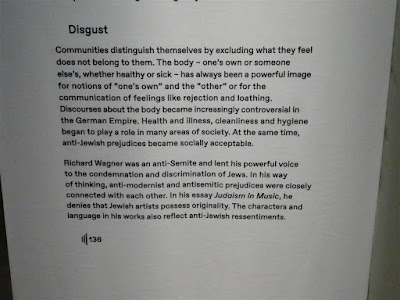I suspect it doesn't translate very well--"Richard Wagner and the Nationalization of Feeling"--and it certainly doesn't convey what's in the exhibit, which was billed, in some quarters, as Germany's finally coming to terms with Wagner's anti-Semitism and other repulsive features. Really. As if the DHM had the final say on a subject widely and fiercely debated, internationally, for going on two centuries! Oh well.
The German Historical Museum/Berlin, its permanent collection, is closed until 2025. Renovations, etc. For us, it's just as well, since it's a vast museum, we've seen it on previous visits, and its emphasis on 20th century German history is not entirely uplifting. But they are doing special exhibits in the I. M. Pei building, of which the Wagner show was one. (Another, concurrently, was on Marx and Capitalism, bringing to mind Barzun's old classic Darwin, Marx, and Wagner, but that's another story.) Daughter Rachel had brought the Wagner exhibition to my attention months ago. It was not something I'd miss.
Anyhow, I toured it Thursday, September 8th. I can't say the exhibit added anything for anyone as steeped in Wagner as I (used to be). But it does place much of Wagner in historical context. Nineteenth century Europe was a place of tumultuous change, and Wagner was an unusually gifted and impressionable child of his times. The exhibition's text was concise but very informative, I thought, and the artifacts--the biggies apparently don't leave their respective homes in Bayreuth, Lucerne, etc.--added to the interest. The show is over now, and I'm glad to have caught it.
 |
Entrance to the Pei building at DHM; I. M. was so
over pyramids after the Louvre project |
 |
| Entering the exhibition, an assemblage of visages of The Master |
 |
Scenes from the Dresden uprising of 1849; Wagner, a life-long
pacifist, was nonetheless one of Bakunin's lieutenants... |
 |
After the Prussian troops arrived, Wagner escaped with a price on his head and spent the next 11 years in exile...Switzerland and Italy mostly; it wasn't his first insurrection either; above, warrants for his arrest |
 |
Among Wagner's earlier operas was Rienzi: The Last
of the Tribunes, a work about revolution...apparently
he was not the only writer who thought Rienzi a fit
topic for an opera: above are notes for such by one
Friedrich Engels, Marx's close personal bud |
 |
| Click to enlarge...the exhibition notes are quite informative |
 |
Wagner of course wrote the librettos to his works as well as the
music--he regarded himself as a fusion of Shakespeare and
Beethoven--and published the librettos in book form well in
advance of the completion of the work and its eventual
performance, sometimes years later; like any decent megalomaniac,
he was a self-promoter par excellence, and the published librettos
built appetite and anticipation for the opera |
 |
The exhibit hall was bordered by copies of photos
from 19th century productions from Bayreuth, all
behind dreamy shrouding... |
 |
| First page of the original score of Das Rheingold |
 |
Among Lenbach's several portraits of Wagner, this
one traveled all the way from Museum Island |
 |
Assorted librettos, etc.; his prose works vastly outnumber his
musical works |
 |
Seating chart, representing W's "democratic," anti-Bourgeois, "Greek" ideals...Richard Wagner and the Birth of Tragedy, Nietzche's early adulation of Wagner...didn't last, however |
 |
| 19th century costume props from Bayreuth |
 |
| Wagner and sycophants, 1860s |
 |
Admitting what is well-known, self-proclaimed since 1853, etc.;
among the things they don't tell you is that, when the best conductor
(Mottl) or best scenic designer (Joukovsky) in Europe were Jewish,
Wagner would have no less; he was even more thoroughly anti-
French, though that appears to mostly escape notice... |
 |
Caricature of W slaying the critics; the Bayreuth
museum used to have a whole small room called
"Anti-Wagner" full of such things; gone last time
I was there; W was ruthless and relentless with his
critics, in both prose and music |
 |
| Thus, the above |
 |
| Depictions, representations of the legacy; and its misuse |
 |
Bayreuth, 1936; again, what they don't tell you is that
several of W's works were banned in Bayreuth during
the Nazi regime--insufficiently German, I guess, or
maybe too Christian--as if W were even remotely a
Christian or could admit a god greater than himself |
 |
Large painting depicting the dedication of the Wagner monument
in Tiergarten Park; I guess it's still there...we've never penetrated
far enough into the park's vast grounds |






















































